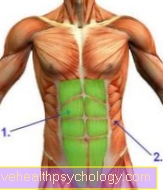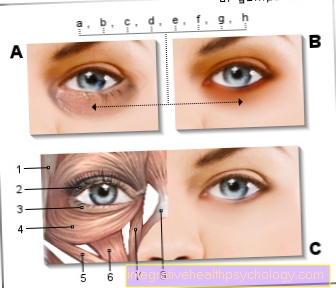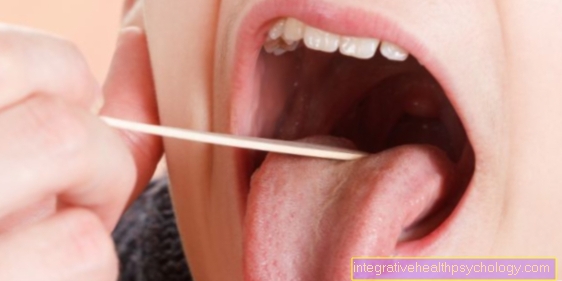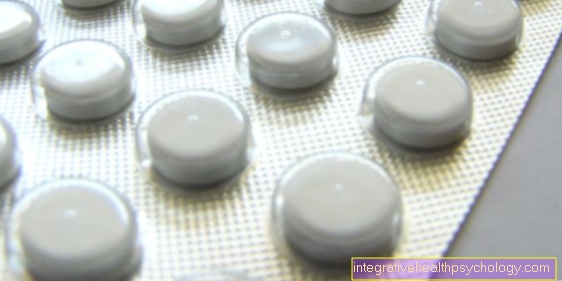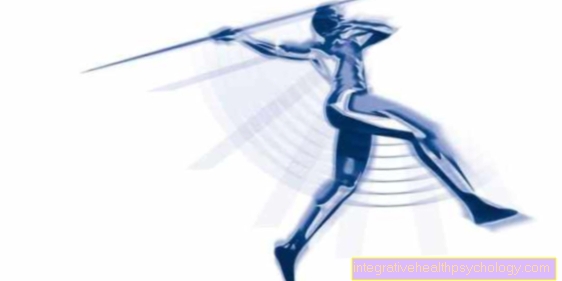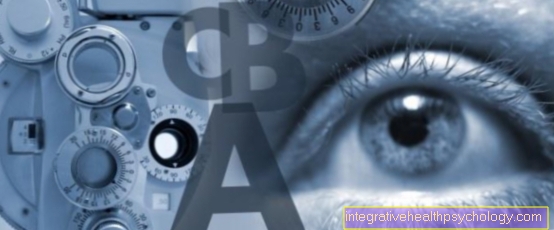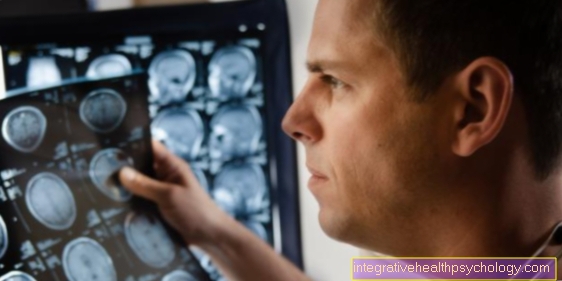meningitis
Synonyms in a broader sense
- Meningitis
- Encephalitis
- Meningoencephalitis
Medical: purulent meningitis or serosa meningitis
English: meningitis, encephalitis, brain inflammation, brain-fever
definition

The term meningitis (meningitis) describes an inflammation (-itis) of the meninges and spinal cord membranes (meninges), which can be triggered by very different pathogens.
There are two types of meningitis:
- purulent meningitis
- non-purulent meningitis
Purulent meningitis (purulent meningitis) is caused by bacteria. It is associated with a high fever and severe general clinical picture and is an absolute emergency that must be treated immediately.
Non-purulent meningitis (non-purulent meningitis), for which viruses are usually responsible, is usually harmless and often occurs in the context of general viral infections (except for herpes simplex encephalitis, which is an acute emergency). The symptoms and the course are milder and the prognosis is better.
Epidemiology / gender distribution
The ratio of purulent meningitis to non-purulent meningitis is approximately 1: 5.
¾ purulent meningitis falls ill before the age of 10.
In Germany there are around 60 meningitis cases per 100,000 inhabitants per year, of which 5 - 10 are due to purulent meningitis.
Infants, toddlers and the elderly are particularly affected because their immune systems are either not yet working or not working as well.
Symptoms of meningitis
At the onset of the disease, symptoms similar to the flu appear, such as fever, body aches and headaches.
As the disease progresses, the specific symptom of neck stiffness occurs, which means that it causes severe pain for those affected when they move their head towards their chest.
In addition, the sick often complain about sensitivity to light and noise.
Babies and toddlers, on the other hand, tend to show unspecific symptoms, such as tiredness, poor drinking and irritability. It can also lead to a bulging fontanel or seizures.
Read more on the subject below
- Meningitis symptoms
- Meningitis signs
- Meningoencephalitis
Pathogen
The spectrum of pathogens is widely spread and varies depending on age, previous illnesses, season and also the transmission route. In principle, any pathogen can also be the cause of meningitis (meningitis).
Depending on the age, various pathogens can be found to cause meningitis (meningitis). There are essentially three groups:
- Newborn
- Toddlers and school children
- Teenagers and adults
In newborns, it is often bacteria such as Escherichia coli and B-streptococci, and more rarely Listeria (Listeria monocytogenes), that cause meningitis.
They are transmitted from mother to child during or immediately after the birth.
In addition, until the introduction of vaccination against the bacterium Haemophilus influenzae (not to be confused with the influenza virus that causes the flu!) In 1990, half of all severe purulent meningitis in childhood affected infants in the first year of life. Since the introduction of this vaccination, these have decreased dramatically.
Read more about the vaccination against meningitis here.
Until the introduction of the Haemophilus influenzae vaccination, these pathogens were also most frequently represented in small and school children; now, as in adolescents and adults, mainly meningococci and pneumococci, followed by listeria (approx. 5%) and staphylococci (1-9%) ).
The inflammation of the meninges caused by the gram-negative bacterium Neisseria meningitidis (meningococcal meningitis, epidemic meningitis; approx. 1 per 100,000 inhabitants per year) only has an incubation time of approx. 1 - 3 days (10 days are possible) and sets within Hours acutely with full symptom intensity. It has a severe, feverish course. In some parts of the world it is endemic, i.e. broad sections of the population are affected. The pathogens are spread by droplet infection (coughing, speaking or sneezing), which is why they can be dangerous in Europe mainly in kindergartens, schools or barracks.
Find out more about the topic here: Meningococcal vaccination
About 10% of people carry the pathogen in the nasopharynx without causing any disease (latent infection).
Among the viral meningitides, echo- and coxsackieviruses (enteroviruses) are most common, less often the mumps virus, the TBE virus (early summer meningo-encephalitis) as well as adenoviruses, polioviruses, etc.
In people with weakened immune systems, such as those with HIV, Leukemia, immunosuppressive therapy (i.e. a therapy that suppresses one's own immune system as in rheumatism / rheumatoid arthritis) or in alcoholics Listeria (Listeria monocytogenes) and Enterococci (<10%) common causative agents of meningitis (meningitis). Also mushroom- and parasitic infections of the meninges occur here more frequently. In addition, these patients will get viral infections in which the viruses have remained in the body or nervous system after an infection (Virus persistence), reactivated more often, i.e. After a long period of rest without symptoms, they cause another disease in the body. Typical representatives here are the viruses of the herpes group: the herpes virus 1 (pathogen of the "Cold sore"), the Cytomegalovirus (CMV), the Varicella zoster virus (VZV, causative agent of chickenpox and the "Shingles“) As well as that Epstein-Barr Virus (EBV, Causative agent of Pfeiffer's glandular fever).
Finally, there are also bacteria that can cause non-purulent meningitis. These include the mycobacterium tuberculosis (Tuberculous meningitis), Treponema pallidum (the causative agent of syphilis, Neurolues) and the Borrelia (the causative agent of Lyme disease, which by one Tick bite is transferred).
Atypical forms of meningoencephalitis (Inflammation of the meninges and the brain) are caused by pathogens such as Rickettsia, Brucellen, Coxielle, the causative agent of sleeping sickness, the malaria and many others.
For the communicable forms of bacterial and abacterial meningitis exists Notification to the health departmentto avoid the spread of the dangerous infectious disease.
CSF diagnostics
To prove meningitis is the Lumbar puncture and examination of the liquor is an absolute standard procedure. However, the type of meningitis is reflected in the individual laboratory values. So it is important to know that meningitis is caused by both bacteria, as well as through Viruses and Mushrooms can be evoked. Typical bacterial pathogens are Meningococci, Pneumococci, Staphylococci etc. Viruses include among others Herpes, Enteroviruses and TBE.
Signs of meningitis can already be identified macroscopically in the cerebral water.A clouding of the liquor indicates an increased number of cells and an increased protein content. The bacteria themselves can also cloud the liquor. If there is a particularly high level of white blood cells, the liquor can even appear purulent.
For a more detailed examination, the brain water is first examined microscopically to determine the number of cells and, if necessary, bacteria with the help of a Grief staining to make visible. However, it should be noted here that bacteria cannot always be found in the CSF in bacterial meningitis. Treatment with Antibiotics make the search even more difficult.
If the number of bacteria is below the detectable limit, a culture is usually created. However, this can take up to 3 days.
In order to distinguish which type of pathogen is causing the meningitis, the individual white blood cells examined more closely and determined their number. With long-standing bacterial meningitis are increased neutrophil granulocytes to be found in the brain water. In the case of viral meningitis, the number of lymphocytes is increased. To diagnose a viral infection, modern methods such as the so-called are increasingly being used in the laboratory Polymerase chain reaction back. The rather rare fungal infection of the meninges can be caused by a high content of eosinophils be detected.
In addition to the microscopic examination of the cerebral water, the clinical Chemistry of great importance for diagnostics. Here you pay particular attention to the total protein, as well as the glucose and lactate concentration. In meningitis, total protein is increased, glucose is decreased, and lactate is increased. This is because more antibodies are formed and the glucose is broken down more, which in turn results in lactate.

.jpg)
